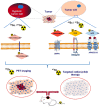Scandium-44: Diagnostic Feasibility in Tumor-Related Angiogenesis
- PMID: 37108559
- PMCID: PMC10138813
- DOI: 10.3390/ijms24087400
Scandium-44: Diagnostic Feasibility in Tumor-Related Angiogenesis
Abstract
Angiogenesis-related cell-surface molecules, including integrins, aminopeptidase N, vascular endothelial growth factor, and gastrin-releasing peptide receptor (GRPR), play a crucial role in tumour formation. Radiolabelled imaging probes targeting angiogenic biomarkers serve as valuable vectors in tumour identification. Nowadays, there is a growing interest in novel radionuclides other than gallium-68 (68Ga) or copper-64 (64Cu) to establish selective radiotracers for the imaging of tumour-associated neo-angiogenesis. Given its ideal decay characteristics (Eβ+average: 632 KeV) and a half-life (T1/2 = 3.97 h) that is well matched to the pharmacokinetic profile of small molecules targeting angiogenesis, scandium-44 (44Sc) has gained meaningful attention as a promising radiometal for positron emission tomography (PET) imaging. More recently, intensive research has been centered around the investigation of 44Sc-labelled angiogenesis-directed radiopharmaceuticals. Previous studies dealt with the evaluation of 44Sc-appended avb3 integrin-affine Arg-Gly-Asp (RGD) tripeptides, GRPR-selective aminobenzoyl-bombesin analogue (AMBA), and hypoxia-associated nitroimidazole derivatives in the identification of various cancers using experimental tumour models. Given the tumour-related hypoxia- and angiogenesis-targeting capability of these PET probes, 44Sc seems to be a strong competitor of the currently used positron emitters in radiotracer development. In this review, we summarize the preliminary preclinical achievements with 44Sc-labelled angiogenesis-specific molecular probes.
Keywords: Arg-Gly-Asp (RGD); aminobenzoyl–bombesin analogue (AMBA); aminopeptidase N (APN/CD13); angiogenesis; carcinogenesis; gastrin-releasing peptide receptor (GRPR); integrin; nitroimidazole; positron emission tomography (PET); scandium-44 (44Sc).
Conflict of interest statement
The authors declare no conflict of interest.
Figures
References
-
- Folkman J. Tumor angiogenesis. In: Holland J.F., Frei E. III, Bast R.C. Jr., editors. Cancer Medicine. 5th ed. B.C. Decker; Hamilton, ON, Canada: 2000. pp. 132–152.
-
- Folkman J. Angiogenesis. In: Braunwald E., Fauci A.S., Kasper D.L., Hauser S.L., Longo D.L., Jameson J.L., et al., editors. Harrison’s Principles of Internal Medicine. 15th ed. McGraw-Hill; New York, NY, USA: 2001. pp. 517–530.
Publication types
MeSH terms
Substances
LinkOut - more resources
Full Text Sources
Miscellaneous


